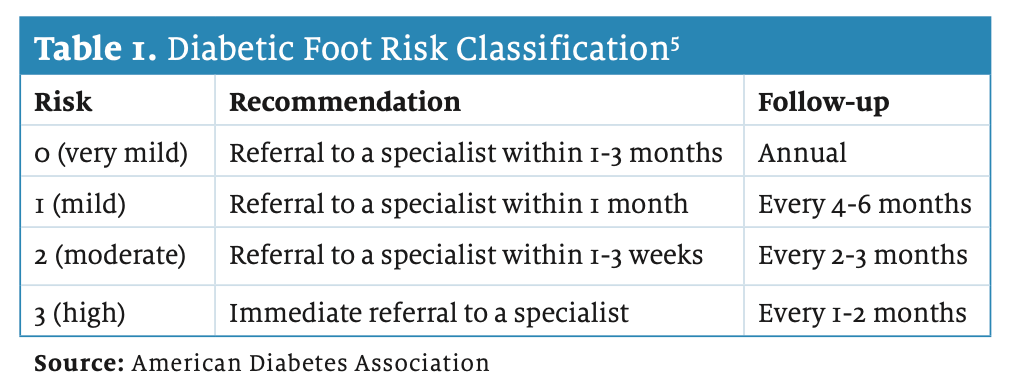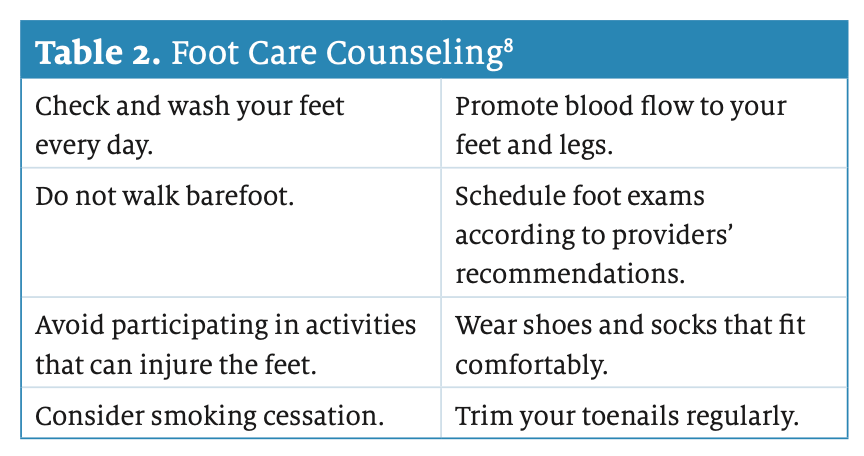Publication
Article
Pharmacy Times
Foot Care Is Essential for Patients With Diabetes
Author(s):
With proper knowledge, they can complete self-examinations and be adherent to clinical exams.
Pharmacists are no strangers to the increasing prevalence of diabetes, but many are unaware that 15% to 25% of patients develop foot complications, so they should keep several points in mind when offering counseling.1
Diabetic Foot Ulcers, Infections
Because diabetic neuropathy tends to develop in these patients, they lose pedal sensation. Diabetic foot ulcers are open sores typically located at the bottom of the foot as the result of foot deformities, irritation, and poor circulation.2,3 When any of these risk factors exist, patients must manage their foot care consistently through self-examination and quarterly clinical exams.
Patients can prevent further complications from diabetes. Elevated blood glucose levels, common in patients with diabetes, can prevent foot ulcers from healing, resulting in diabetic foot infections. These infections, defined as a soft tissue or bone infection below the malleoli (the protuberance on both sides of the ankle joint), are classified as mild, moderate, or severe.4 If cuts and scrapes are untreated, life-altering and life-threatening infections are possible. Most importantly, a diabetic foot infection is the most frequent cause of diabetes-associated lower extremity amputation.3,4 Prescribers can use antibiotics to treat mild infections. However, as the severity of the infection increases, so does the gravity of the intervention.4
Preventative Care
Proper debridement can prevent foot ulcers from developing into serious infections.2 Because patients with diabetes have a greater risk of complications resulting in higher health care costs, prevention is the major key in diabetic foot care. The American Diabetes Association (ADA) and CDC’s recommendations on foot screenings and education on foot hygiene are parallel.5 The ADA also compiled a 0 to 3 diabetic foot risk classification with recommendations and follow-up care.5 Table 15 presents the ADA recommendations based on risk classification.

The National Institute of Diabetes and Digestive and Kidney Diseases suggests that a diabetes care plan including a podiatrist is vital to patients’ health.6,7 Table 28 provides examples of counseling points that pharmacists should communicate to all patients.

Diabetic Foot Infection Treatment Recommendations
Patients with foot-related concerns often ask for help from pharmacists. Understanding the necessary steps for ensuring patient health and safety is important.
OTC Recommendations
The formation of calluses and corns is common in individuals with diabetes. Salicylic acid is a widely available OTC product that is useful for treating them, but patients with diabetes should not self-treat. Instead, they can soak with warm water for approximately 5 minutes to soften dead tissue for gentle removal.8 If patients seek pain relief, pharmacists can recommend using cushioning pads in shoes to eliminate pressure.8 Self-treatment guidelines
for ingrown toenails also exclude patients with diabetes. Pharmacists can offer counseling about proper nail trimming to prevent ingrown nails and to ensure that patients see a podiatrist regularly.8
Prescription Recommendations
Initial antibiotic regimens for foot infections are empiric.4,9 Once cultures of the infected wound are available, providers may streamline therapy. For mild infections, amoxicillin-clavulanate and cephalexin are acceptable options.9 In the early 2000s, the FDA approved ertapenem, linezolid, and piperacillin-tazobactam for the treatment of complicated diabetic foot infections.9 Although duration of treatment is based on severity, most patients’ infections clear within 1 to 2 weeks. Infections associated with osteomyelitis typically need 4 to 6 weeks of therapy. Severe diabetic foot infections require surgical intervention. The Infectious Diseases Society of America (IDSA) recommends that patients with diabetes receive wound care, including debridement, pressure redistribution, and dressing of the wound.9 IDSA guidelines emphasize that diabetic foot care teams should include a clinical microbiology specialist, an infectious disease specialist, and a surgeon.9
Patients taking antibiotics may experience digestive issues, such as loss of appetite, nausea, and vomiting. Pharmacists should counsel patients to avoid alcohol, take medication as directed in its entirety, and use probiotics.10 Pharmacists have a responsibility to encourage patient adherence for the duration of therapy to prevent infection recurrence.
Conclusion
Foot care is tremendously important to all patients with diabetes. One key facilitator of diabetes foot care is patient education. With the proper knowledge, patients can complete self-examinations and be adherent to their clinical exams. Pharmacists are pivotal in this process and can successfully promote positive preventive care practices.
About The Author
Karisse Lora is a PharmD candidate at the University of Connecticut School of Pharmacy in Storrs.
References
1. Yazdanpanah L, Shahbazian H, Nazari I, et al. Incidence and risk factors of diabetic foot ulcer: a population-based diabetic foot cohort (ADFC study)-two-year follow-up study. Int J Endocrinol. 2018;2018:7631659. doi:10.1155/2018/7631659
2. Frequently asked questions: diabetic foot ulcers. University of Michigan Health. Accessed July 11, 2022. https://www.uofmhealth.org/conditions-treatments/podiatry-foot-care/frequently-asked-questions-diabetic-foot-ulcers
3. Bandyk DF. The diabetic foot: pathophysiology, evaluation, and treatment. Semin Vasc Surg. 2018;31(2-4):43-48. doi:10.1053/j.semvascsurg.2019.02.001
4. Gemechu FW, Seemant F, Curley CA. Diabetic foot infections. Am Fam Physician. 2013;88(3):177-184.
5. Boulton AJM, Armstrong DG, Kirsner RS, et al. Diagnosis and management of diabetic foot complications. American Diabetes Association; 2018.
6. Song K, Chambers AR. Diabetic foot care. In: StatPearls. StatPearls Publishing; May 1, 2022.
7. Diabetes and your feet. CDC. Updated May 7, 2021. Accessed July 11, 2022. https://www.cdc.gov/diabetes/library/features/healthy-feet.html
8. Srivasta SB. Minor foot disorders. In: Berardi RR, ed. Handbook of Nonprescription Drugs: An Interactive Approach to Self-Care. 20th ed. American Pharmacists Association; 2009.
9. Lipsky BA, Berendt AR, Cornia PB, et al; Infectious Diseases Society of America. 2012 Infectious Diseases Society of America clinical practice guideline for the diagnosis and treatment of diabetic foot infections. Clin Infect Dis. 2012;54(12):e132-e173. doi:10.1093/cid/cis346
10. How to reduce the side effects of antibiotics. UPMC HealthBeat. January 8, 2016. Accessed July 11, 2022. https://share.upmc.com/2016/01/how-to-reduce-side-effects-of-antibiotics/






